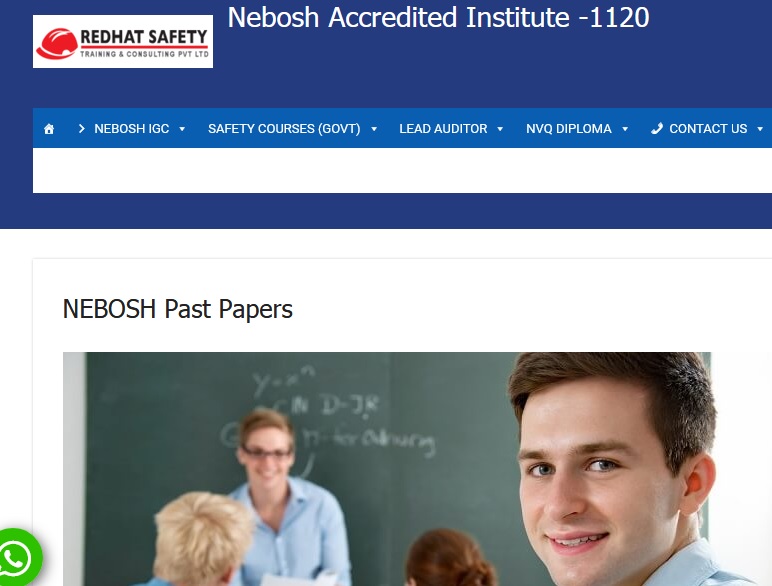NEBOSH International General Certificate Question Paper : redhatsafety.com
Name of the Organisation : RedHat Safety Training and Consulting Pvt Ltd
Exam : NEBOSH International General Certificate
Subject : Occupational Health And Safety
Year : 2016
Document Type : Model & Past Question Papers
Website : https://www.redhatsafety.com/
Download Model/Sample Question Paper :
NEBOSH Past Paper IGC 1 : https://www.pdfquestion.in/uploads/13373-IGC1PPNEBOSH.pdf
NEBOSH Past Paper GC 2 : https://www.pdfquestion.in/uploads/13373-IGC2PPNEBOSH.pdf
RedHat NEBOSH General Certificate Question Paper
NEBOSH International General Certificate in Occupational Health And Safety Question Paper :
Instruction
** Answer both Section 1 and Section 2. Answer ALL questions.
** The maximum marks for each question, or part of a question, are shown in brackets.
Related : Jadavpur University Safety In Process Industries B.E Question Paper : www.pdfquestion.in/6583.html
** Start each answer on a new page.
** Answers may be illustrated by sketches where appropriate.
** This question paper must be returned to the invigilator after the examination.

Model Questions
Section 1 :
You are advised to spend about half an hour on this section, which contains ONE question.
1 (a) Give the meaning of the term ‘hazard’ AND give an example of a workplace hazard. (3)
(b) Give the meaning of the term ‘risk’ AND give an example of a workplace risk. (3)
(c) Outline the key stages of the risk assessment process, identifying the issues that would need to be considered at EACH stage. (10)
(d) Outline the criteria which must be met for the assessment to be ‘suitable and sufficient’. (4)
Section 2 :
You are advised to spend about one and a half hours on this section, which contains TEN questions.
2 (a) Outline the purpose of the three main sections of an organisation’s health and safety policy. (6)
(b) Give reasons why the health and safety policy should be signed by the most senior person in an organisation, such as a Managing Director or Chief Executive Officer. (2)
3 Identify :
(a) FOUR active (proactive); (4)
(b) FOUR reactive (4)
means by which an organisation can monitor its health and safety performance.
4 (a) Give the meaning of the term ‘hierarchy of control’. (2)
(b) Outline, with examples, the general hierarchy that should be applied with respect to controlling health and safety risks in the workplace. (6)
5 Outline ways in which an organisation could encourage workers to be involved in setting and maintaining high standards of health and safety. (8)
6 An organisation is introducing a new work activity that requires a safe system of work.
Outline:
(a) why it is important to involve workers in the development of a safe system of work; (4)
(b) why it is important for safe systems of work to have written procedures. (4)
7 A machine has leaked hot liquid into a work area. No-one has been injured.
Outline reasons why it is important for an organisation to investigate ‘near miss’ incidents. (8)
8 (a) Outline the main health and safety responsibilities of employers. (6)
(b) Identify actions an enforcement authority might take if it finds that an employer is not meeting its responsibilities. (8)
9 Outline reasons why an organisation should review its health and safety performance. (8)
10 Identify possible costs to an organisation following an accident in the workplace. (8)
11 (a) Give the meaning of the term ‘perception’. (2)
(b) Outline ways in which workers’ perceptions of hazards in the workplace might be improved. (8)
Control Of International Workplace Hazards :
Section 1 :
You are advised to spend about half an hour on this section, which contains ONE question.
1 (a) Give the meaning of the term ‘health surveillance’. (2)
(b) Identify the types of checks that could be included in a health surveillance programme. (6)
(c) Give the meaning of a short term exposure limit (STEL) AND a long term exposure limit (LTEL). (6)
(d) Outline the limitations of exposure limits (ELs). (6)
Section 2 :
You are advised to spend about one and a half hours on this section, which contains TEN questions.
2 (a) Identify THREE control measures to segregate pedestrians and vehicles in the workplace. (3)
(b) Identify measures to reduce the risk to pedestrians when segregation is not practicable. (5)
3 The construction industry has a high incidence of contact dermatitis.
(a) Identify FOUR substances used in construction that could cause contact dermatitis. (4)
(b) Outline control measures that could be used to reduce the risk of contact dermatitis. (4)
4 (a) Identify the possible effects of electricity on the body. (4)
(b) Identify the emergency action to take if a person suffers a severe electric shock. (4)
5 Identify FOUR types of engineering control that may be used to reduce noise in the workplace AND give a practical example of EACH. (8)
6 (a) List FOUR specific types of injury that could be caused by the incorrect manual handling of loads. (4)
(b) Identify factors in relation to the load that will affect the risk of injury. (4)
7 (a) Identify FOUR health effects of working outside in extreme heat created by the sun. (4)
(b) Outline control measures that could be used to reduce the effects of the sun on construction workers. (4)
8 In a factory a conveyor system is used to transfer manufactured articles to the warehouse area.
Identify the control measures to be taken to reduce the risk of injury to workers from the conveyor. (8)
9 (a) Identify the key components of the ‘fire triangle’. (3)
(b) Identify sources of ignition that may cause a fire to occur, AND give a typical workplace example of EACH. (5)
10 Outline the hazards and risks to which a worker could be exposed when cutting down a tree using a petrol driven chainsaw. (8)
11 (a) Identify TWO types of asbestos to which workers in the construction
industry may be exposed. (2)
(b) Give examples of where workers might find asbestos while undertaking maintenance or refurbishment work on a building. (6)